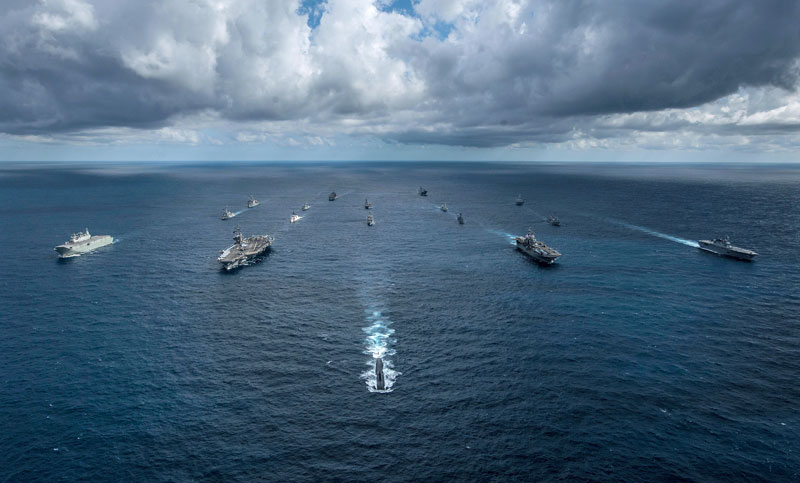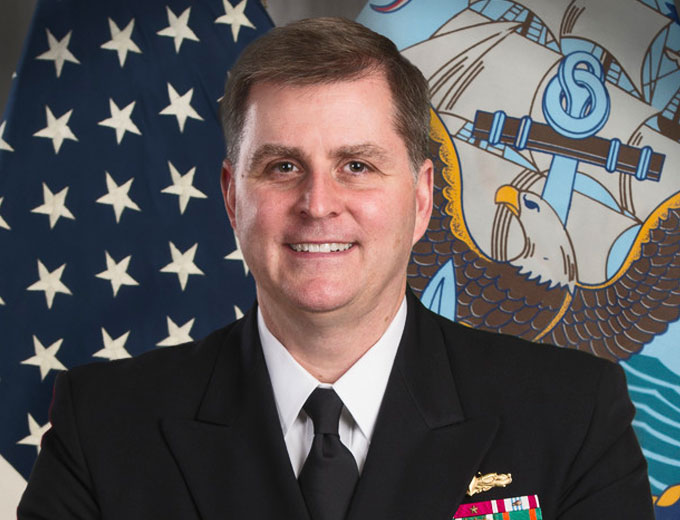
Seventeen ships from the United States, Australia, Canada and Japan sailed together in formation for a massive photo exercise July 10, to signify the beginning of naval maneuvers as part of Exercise Talisman Sabre 2019.
A bilateral, biennial event, Talisman Sabre is designed to improve U.S. and Australian combat training, readiness and interoperability through realistic, relevant training necessary to maintain regional security, peace and stability.
This year’s Talisman Sabre is focused on defending the rights, freedoms, and uses of the sea, air, space and cyberspace guaranteed to all nations under international law and considered essential to prosperity, stability and security in the Indo-Pacific region.

“Interoperability and working alongside allies and partners really is the future, particularly in the Pacific,” said Rear Admiral Fred Kacher, Commander, Expeditionary Strike Group 7.
“It’s just too important, too large a region, for us not to reach out and work together with our great allies and partners in the region.”

“Australia in particular, in a very important part of the world, has been a steadfast and longstanding ally who has fought and served alongside us for over a century.”
“So for us, having the chance to integrate with them in a high-end exercise like Talisman Sabre is a tremendous opportunity.”
U.S. naval participation included units from the Ronald Reagan Carrier Strike Group and Wasp Expeditionary Strike Group.
The Royal Australian Navy participated with the Canberra-class landing helicopter dock (LHD) lead ship HMAS Canberra (LO2) and Canberra-class landing helicopter dock (LHD) HMAS Adelaide (LO1).
(Four US Marine Corps HIMARS multiple launch rocket systems conduct a live fire drill after rolling out the back of C-130 Hercules transports during Exercise Talisman Sabre in early July 2019, at the Shoalwater Bay Training Area, central Queensland. The Australian Army is looking to acquire its own long-range rocket capability by the mid-2020s under Project Land 8113. Courtesy of Defence Technology Review Magazine and YouTube. Posted on July 11, 2019.)
Japan also participated in the photo exercise with Japan Maritime Self-Defense Force sumi-class amphibious transport dock ship JS Kunisaki (LST 4003) and Japan Maritime Self-Defense Force Hyga-class helicopter destroyer JS Ise (DDH 182), while Canada represented with their Royal Canadian Navy Halifax-class frigate HMCS Regina (FFH 334) and auxiliary oiler replenishment MV Asterix (T-AKE-14).

“Talisman Sabre ‘19 is a tremendous opportunity for the Ronald Reagan Carrier Strike Group to train in a joint and combined environment, improve our sailors’ proficiency and sharpen our warfighting skills,” explained Rear Admiral Karl Thomas, Commander, Task Force 70.
“As a forward deployed force, we routinely train and operate alongside our allies, partners and friends, but complex exercises like this ensure we can operate seamlessly as one lethal and cohesive team throughout this important Indo-Pacific region.”
The bilateral exercise provides an opportunity to fully integrate all domains of warfare, to include air, land, maritime, space, and information, and enhance Australian and U.S. interoperability in combined and joint warfare at the tactical level by conducting a single field training exercise, focused on amphibious operations.
On July 12th Prime Minister of Australia Scott Morrison visited USS Ronald Reagan (CVN 76) underway in the Coral Sea during Talisman Sabre.
(Prime Minister Scott Morrison touched down on the American naval warship USS Ronald Reagan as a guest to the US Ambassador ahead of Operation Talisman Sabre war games. Courtesy of Sky News Australia and YouTube. Posted on Jul 12, 2019.)
While aboard Ronald Reagan, the Prime Minister met with several senior ranking U.S. Navy officials during a tour of the ship, observed flight operations and spoke with the Ronald Reagan crew during an all hands call.
“We couldn’t be more pleased that you’re here and we certainly thank you for your participation,” said Morrison.
“It’s particularly an honor to be here in the hangar of the USS Ronald Reagan.
“This is an extraordinary symbol not only of American power, but of the United States commitment to the many nations of this region, in which we live, and their security.”
Rear Admiral Karl O. Thomas, Commander Task Force 70, and Capt. Patrick Hannifin, commanding officer USS Ronald Reagan, explained the day-to-day operations aboard the aircraft carrier and throughout the strike group during the Prime Minister’s visit.
“We are privileged today to have the leader of one of our closest allies onboard USS Ronald Reagan,” added Thomas.
“We are incredibly fortunate to count Australia as a close ally and friend, and look forward to operating together during exercise Talisman Sabre.”
“Over the next few weeks, alongside our friends from New Zealand, The United Kingdom, Canada and Japan, 25,000 men and women will participate in this grueling exercise,” said Morrison.

“You will put yourself to the tests and ensure that ours is a seamless partnership, one that works on the seas, on the ground and in the air.
“On behalf of the Australian government and Australian people and my colleagues who are here to today I thank you all very much for your service.”
The U.S. and Australia train and work together in a variety of exercises and missions throughout the year, including humanitarian and civic assistance during missions in the Indo-Pacific.
Among the group that toured with Morrison were the Honorable Arthur B. Culvahouse Jr., the U.S. Ambassador to Australia, the Honorable Richard Marles, the Shadow Minister for Defense, the Honorable Frances Adamson, the Secretary of the Department of Foreign Affairs and Trade, Greg Moriarty, the Secretary of the Department of Defense, and Gen. Angus Campbell, the Chief of Defense Force.
Talisman Sabre 2019 illustrates the closeness of the Australian and U.S. alliance and the strength of the military-to-military relationship. This is the eighth iteration of this exercise.
Ronald Reagan is forward-deployed to the U.S. 7th Fleet area of operations in support of security and stability in the Indo-Pacific region.
The following US ships are participating in Talisman Sabre 2019 off the coast of Northern Australia.
- USS Ronald Reagan (CVN 76)
- Carrier Air Wing Five (CVW-5)
- Destroyer Squadron (DESRON) 15
- USS Chancellorsville (CG 62)
- USS William P. Lawrence (DDG 110)
- Wasp Expeditionary Strike Group, consisting of:
- Amphibious Squadron 11
- Embarked 31st Marine Expeditionary Unit,
- Arleigh Burke-class destroyer USS McCampbell (DDG 85), and
- Legend-class cutter USCGC Stratton (WMSL 752)

















